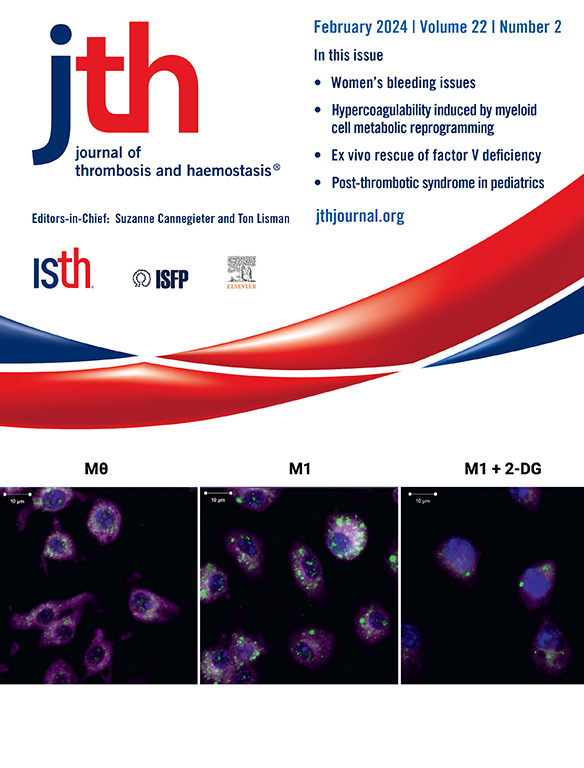Mice with reduced protease-activated receptor 4 reactivity show decreased venous thrombosis and platelet procoagulant activity
IF 5.5
2区 医学
Q1 HEMATOLOGY
引用次数: 0
Abstract
Background
Hypercoagulation and thrombin generation are major risk factors for venous thrombosis. Sustained thrombin signaling through protease-activated receptor (PAR) 4 promotes platelet activation, phosphatidylserine exposure, and subsequent thrombin generation. A single nucleotide polymorphism in PAR4 (rs2227376) changes proline to leucine extracellular loop 3, which decreases PAR4 reactivity and is associated with a lower risk for venous thromboembolism (VTE) in a genome wide association studies meta-analysis.
Objectives
The goal of this study was to determine the mechanism for the association of rs2227376 with a reduced risk of VTE using mice with a homologous mutation (PAR4-P322L).
Methods
Venous thrombosis was examined using our recently generated PAR4-P322L mice in the inferior vena cava stasis and stenosis models. Coagulation and clot stability were measured using rotational thromboelastometry. Thrombin-generating potential was measured in platelet-rich plasma. Phosphatidylserine surface expression and platelet-neutrophil aggregates were analyzed using flow cytometry.
Results
Mice heterozygous (PAR4P/L) or homozygous (PAR4L/L) at position 310 had reduced sizes of venous clots at 48 hours. PAR4P/L and PAR4L/L platelets had progressively decreased phosphatidylserine in response to thrombin and convulxin, in addition to decreased thrombin generation and decreased PAR4-mediated platelet-neutrophil aggregation.
Conclusion
The leucine allele in extracellular loop 3, PAR4-322L, leads to fewer procoagulant platelets, decreased endogenous thrombin potential, and reduced platelet-neutrophil aggregation. This decreased ability to generate thrombin and bind to neutrophils offers a mechanism for PAR4’s role in VTE, highlighting a key role for PAR4 signaling.
PAR4反应性降低的小鼠显示静脉血栓形成和血小板促凝活性降低。
背景:高凝和凝血酶的产生是静脉血栓形成的主要危险因素。通过PAR4的持续凝血酶信号传导促进血小板活化、磷脂酰丝氨酸暴露和随后的凝血酶生成。GWAS荟萃分析显示,PAR4 (rs2227376)的单核苷酸多态性将脯氨酸转变为亮氨酸细胞外环3 (P310L),从而降低PAR4的反应性,并与静脉血栓栓塞(VTE)风险降低相关。目的:本研究的目的是确定rs2227376与同源突变(PAR4-P322L)小鼠VTE风险降低的关联机制。方法:采用新制备的PAR4-P322L小鼠下腔静脉停滞和狭窄模型检测静脉血栓形成。使用旋转血栓弹性测量仪(ROTEM)测量凝血和凝块稳定性。在富血小板血浆中测定凝血酶生成电位。流式细胞术分析磷脂酰丝氨酸表面表达和血小板-中性粒细胞聚集。结果:PAR4P/L和PAR4L/L在48小时静脉血栓大小减小。在凝血酶和惊厥素的作用下,PAR4P/L和PAR4L/L血小板的磷脂酰丝氨酸逐渐降低,凝血酶生成减少,par4介导的血小板-中性粒细胞聚集减少。结论:细胞外环3 PAR4-322L中的亮氨酸等位基因导致促凝血小板减少,内源性凝血酶电位降低,血小板-中性粒细胞聚集减少。这种产生凝血酶和与中性粒细胞结合能力的下降为PAR4在VTE中的作用提供了一种机制,强调了PAR4信号传导的关键作用。
本文章由计算机程序翻译,如有差异,请以英文原文为准。
求助全文
约1分钟内获得全文
求助全文
来源期刊
CiteScore
24.30
自引率
3.80%
发文量
321
审稿时长
1 months
期刊介绍:
The Journal of Thrombosis and Haemostasis (JTH) serves as the official journal of the International Society on Thrombosis and Haemostasis. It is dedicated to advancing science related to thrombosis, bleeding disorders, and vascular biology through the dissemination and exchange of information and ideas within the global research community.
Types of Publications:
The journal publishes a variety of content, including:
Original research reports
State-of-the-art reviews
Brief reports
Case reports
Invited commentaries on publications in the Journal
Forum articles
Correspondence
Announcements
Scope of Contributions:
Editors invite contributions from both fundamental and clinical domains. These include:
Basic manuscripts on blood coagulation and fibrinolysis
Studies on proteins and reactions related to thrombosis and haemostasis
Research on blood platelets and their interactions with other biological systems, such as the vessel wall, blood cells, and invading organisms
Clinical manuscripts covering various topics including venous thrombosis, arterial disease, hemophilia, bleeding disorders, and platelet diseases
Clinical manuscripts may encompass etiology, diagnostics, prognosis, prevention, and treatment strategies.

 求助内容:
求助内容: 应助结果提醒方式:
应助结果提醒方式:


